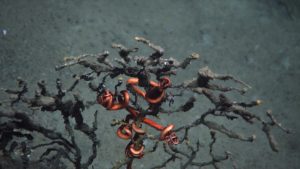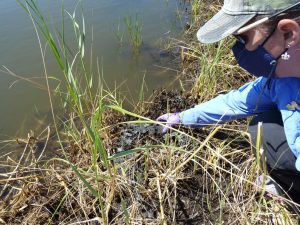Gulf of Mexico Oil Spill Researchers Look into Effects on Wildlife, Ways to Improve Response
– April 16, 2012
LSU entomologist Linda Hooper-Bui and her graduate students spent a day last week putting down cages, each one containing 20 brown crickets, among sprigs of smooth cordgrass in a marsh by Bay Jimmy.
(From Nola.com / by Mark Schleifstein, The Times-Picayune) — The bay in western Plaquemines Parish remains ground zero for efforts to clean remaining oil from the 2010 BP Deepwater Horizon oil spill, and also has become a focal point of research into the spill’s effects on the environment.
Liquid, brownish-black oil continues to ooze from the soil in several places when it’s stepped on, and asphaltic maps of weathered oil dot the marsh surface.
The cages are placed 65 feet from oiled areas. While Bui says she doesn’t know whether the crickets will survive this spring, she’s not optimistic.
“When the marsh’s sediment is exposed and the temperature gets above 85 degrees Fahrenheit, the oil is being biologically degraded, the oil is releasing volatiles and is killing the crickets,” she said.
The problem is a combination of vapors given off by the weathered oil that scientists call BTEX, which stands for benzene, toluene, ethylbenzene and xylenes. The highly toxic gases are believed responsible for the deaths of crickets in similar experiments last year at this location.
Her students also are finding that, in oiled areas, acrobat ants — their scientific name is Crematogaster pilosa — have mostly abandoned the hollow stems of the smooth cordgrass, where they normally forage for food.
In 2010, after the first oil hit Louisiana’s beaches, her students found an average 10 ants per stalk in oiled areas, compared with 34 in unoiled areas. By September, the average had dropped to less than a single ant per stalk in the oiled area.
Bui’s work represents only a tiny fraction of the massive volume of research being conducted locally in the two years since the Deepwater Horizon disaster as scientists attempt to explain what happened to the oil from the BP Macondo well, and its short-term and long-term effects on wildlife and humans.
Oil, gas largely gone
Snapshots of their findings have dribbled out in the form of peer-reviewed papers over those two years, with results that scientists have described as both promising, in terms of the speed with which the oil and gas have largely disappeared; and disconcerting, in terms of evidence that some toxic chemicals linked to the spill are making their way up the food chain to larger species and humans.
The research falls into three main categories: independent studies financed by grants from traditional science benefactors such as the federally funded National Science Foundation; studies commissioned by the Gulf of Mexico Research Initiative that are chosen and overseen by a team of independent researchers and underwritten by a 10-year, $500 million grant from BP; and a myriad of studies sponsored by federal and state agencies and Indian tribes and by BP as part of the federally required Natural Resource Damage Assessment process.
Studies from the first two categories are slowly being released after peer review.
The BP spill was unprecedented in how it happened and its potential effects, because the 4.9 million barrels of oil and a still-unknown amount of natural gas were released nearly a mile below the ocean’s surface. Much of the hot oil and gas immediately mixed with seawater and formed tiny droplets, bubbles of gas and crystals of frozen methane, much of which stayed in a plume that remained a half-mile to three-quarters of a mile below the surface.
Up the food chain
Published studies indicate the material in that plume was quickly eaten by microorganisms, which were then eaten by larger organisms, with some of the oil constituents making their way up the food chain.
“There’s clear evidence that some of the carbon in the food chain was from the oil,” said marine scientist Don Boesch, president of the University of Maryland Center for Environmental Science and a member of President Barack Obama’s oil spill commission.
“A fairly recent paper shows some oil compounds themselves, not things turned into tissue, have been found in higher organisms,” he said.
About half the oil and some of the ice crystals did make it to the surface, but the journey weathered the oil and melted the crystals, and possibly stripped some of the more dangerous chemicals from them, Boesch said.
But there’s still concern that some of the oil droplets or microbes that ate the droplets and then died rained down on a large area of the seafloor around the well, said Samantha Joye, a marine scientist at the University of Georgia whose research spotted such material on and around deepwater coral reefs about 10 miles north of the well.
A study published in the Proceedings of the National Academy of Sciences in March found corals on those reefs were dead, and that “fingerprinting” of oily material on them matched the BP oil.
A January study published in Geophysical Research Papers found that tiny plankton that serve as food for early-life stages of fish and shrimp also contained toxic polyaromatic hydrocarbons linked to BP oil. The plankton were found in a wide area to the north and south of the BP well, including at the mouth of the Mississippi River.
Dreaded bacteria in tar balls
And a March study in the journal EcoHealth by Auburn University researchers found that tar balls washing up on beaches in Mississippi and Alabama contain Vibrio vulnificus bacteria at levels 10 times higher than in nearby sand and 100 times greater than in seawater.
Vibrio is a source of rare infections that can cause life-threatening vomiting, diarrhea, abdominal pain and dermatitis. It is transmitted by eating contaminated seafood or through open cuts.
Some studies are having trouble getting off the ground, such as a National Institutes of Health/National Institute of Environmental Health Sciences proposal to monitor for 10 years the health of as many as 150,000 people who participated in the cleanup. As of late February, only 10,000 workers had agreed to participate.
Finding a better dispersant
Some of the BP-sponsored studies, meanwhile, are aimed at finding ways of reducing damage from response strategies during the next spill.
An example is research into new chemical compounds that could be used to disperse oil, being conducted by a national team of scientists led by Tulane University chemist Vijay John.
“We operate under the premise that for spills like the Deepwater Horizon, the use of dispersants is necessary,” John said. “There’s been a lot of pressure to use more skimmers, but all the world’s ships and skimmers can pick up only a tiny fraction of what was spilled.”
The dispersants used during the BP spill were not designed to be sprayed into oil and gas and gas crystals a mile below the surface, he said.
“Can you cut down on their toxicity and make them more effective?” he asked rhetorically. He’s looking into dispersants that are delivered in dry form or encapsulated to reduce the need for toxic constituents.
That job is likely to take up to 10 years, he said, in part because different compounds are likely to be required for different environments, such as the extreme cold of the waters in Alaska.
“To be able to replace existing dispersants will take time and a clear demonstration of new materials and compounds that work significantly better than the old ones,” he said.
Research kept under wraps
The results of much of the research conducted under the Natural Resource Damage Assessment process has been kept under wraps while the government and BP continue to prepare for what could be a contentious trial to determine how much BP and other responsible parties may owe in federal Clean Water Act fines and NRDA-required projects to compensate for damage caused by the spill.
A study examining why hundreds of bottlenose dolphins have become stranded in Barataria Bay, with most dying, is one of the few cases where open research is combining with the NRDA process. NOAA-sponsored scientists had been tracking an “unusual mortality event” in the bay since February 2010, two months before the spill. Initial information found evidence that some of the dolphins had been killed by brucellosis, a lung disease better known for killing cows.
Researchers are studying whether oil that the dolphins swam through, or fumes they breathed, might have made them susceptible.
But still under wraps in the NRDA process are possible scientific forays into whether certain species of fish, land-based mammals or seagoing or shoreline birds have been affected by the spill.
Bui’s research is part of a $12 million, three-year study of the effects of the spill on near-shore and coastal environments that includes 26 scientists from a dozen universities around the nation. The team’s lead investigator, marine biologist Nancy Rabalais, is director of the Louisiana Universities Marine Consortium in Cocodrie.
Money for the study comes from the BP Gulf research initiative, which is paid for by the oil giant but overseen by a board of nationally known, independent scientists.
Study of fish inner ears
Rabalais said others in her group are studying the effects of oil on the above- and below-ground growth of marsh plants, and on species of fish and mussels. One scientist will study the bony otolith — inner ear — of fish for signs that oil affects their growth. Growth patterns of otoliths are similar to the rings of trees.
A similar study will be conducted of growth rings in mussel shells, she said.
Such studies are necessary to determine long-term effects, she said.
“Here, the marsh may look OK now, but there’s still a lot of oil out there,” Rabalais said. “But explaining exposure of marsh organisms is a complex task. When you’re trying to attribute an effect to oil versus other factors, the science is difficult.”
Complicating that process is the lack of pre-spill data, Rabalais and other scientists said.
In an article published this week in the Proceedings of the National Academy of Sciences, 22 researchers who have participated in BP studies challenged Congress to rewrite parts of the Oil Pollution Act to require spending more money on research before and after spills on the organisms that can be affected, including humans.
Unprepared in deep water
The BP disaster proved both scientists and regulators were preparing for a shallow-water spill, where the biggest concerns were onshore contamination of wildlife, the environment and humans. In fact, the spill represented an unprecedented threat to both onshore and deepwater resources, said lead author and University of North Carolina marine scientist Charles Peterson.
Congress made matters worse, Peterson said, by not making deepwater-drilling permits in the central and western Gulf of Mexico, including the BP well, require more extensive environmental reviews before the spill.
Joye, a co-author of the paper, said Congress also should require oceangoing research ships to be stationed full time in the Gulf and other drilling locations.
“GoMRI In the news” is a reposting of articles about GoMRI-funded research (published by various news outlets). The author’s interpretations and opinions expressed in these articles is not necessarily that of GoMRI.







